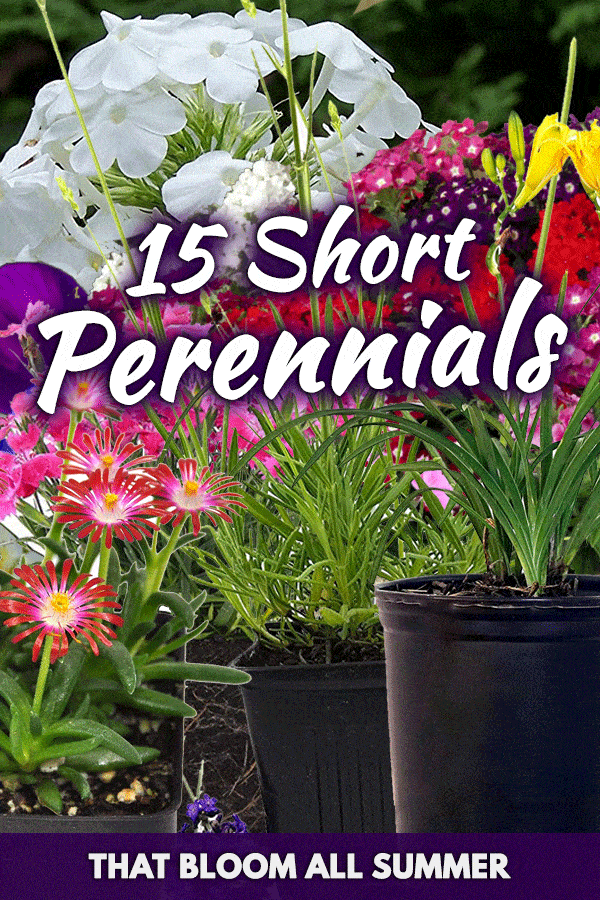If you're searching for low-growing perennials that bloom all summer, look no further.
Perennials have a special way of infusing life and vibrancy into gardens; when they're short in stature, they offer a unique charm.
These short perennials not only beautify your garden's foreground but also ensure a burst of color throughout the summer months.
In this guide, we're showcasing 15 top short perennials that bloom all summer long.
No matter the size of your yard, from grand to intimate, these plants will add charm to your outdoor haven.
These delightful selections will breathe new life into your garden vision!
Top 15 Summer-Long Perennials And Breathtaking Blooms
Want a colorful garden all summer? This guide is for you.
We list great plants that bloom for months. From wildflowers to sweet-smelling lavender, these plants will brighten your garden.
They're easy to care for and look great. Learn about each plant, how to care for them, and where to buy them.
Let's get started!
At-a-Glance Plant Overview Preview
| Plant Name | Flower Characteristics | USDA Zones | Light & Soil Requirements |
|---|---|---|---|
| Phlox | Clusters in various colors | 4-8 | 6+ hrs sun; moist, well-draining soil |
| Perennial Geranium | Cup-shaped; various colors | 5-9 | Partial shade; well-draining soil |
| Lavender | Spikes in lavender, white, pink, yellow | 5-8 | Full sun; well-draining, dry soil |
| Stella de Oro | Yellow; trumpet-shaped | 3-9 | Full sun to partial shade; well-draining soil |
| Ice Plant | Daisy-like; various colors | 5-9 | 6+ hrs sun; well-draining soil |
| Dianthus | Carnation-like; various colors | 3-9 | Full sun; well-draining soil |
| Dwarf Sea Holly | Purplish-blue blooms | Cup flower: white or bluish-purple | 6+ hrs sun; well-draining soil |
| Periwinkle | Continuous blooms; various colors | 4-9 | Full to partial sun; well-draining soil |
| Perennial Violet | Various colors with scalloped foliage | 2-11 | Full to partial sun; nutrient-rich soil |
| Bellflower | Bell-shaped; various colors | 4-8 | Full sun; well-draining soil |
| Nierembergia | Cup flower; white or bluish-purple | 7-10 | Full to partial sun; well-draining soil |
| Verbena | Clusters; various colors | 2-8 | 6+ hrs sun; well-draining soil |
| Alyssum | Small blooms in white, pink, purple | 7-11 | Full to partial sun; well-draining soil |
| Midget Pincushion Plant | Ruby red, round blooms | 5-8 | Full sun; well-draining soil |
| Eastern Pasqueflower | Bright Purple Blossoms | 3-8 | Full to partial sun; well-draining soil |
1. Phlox (Phlox paniculata)
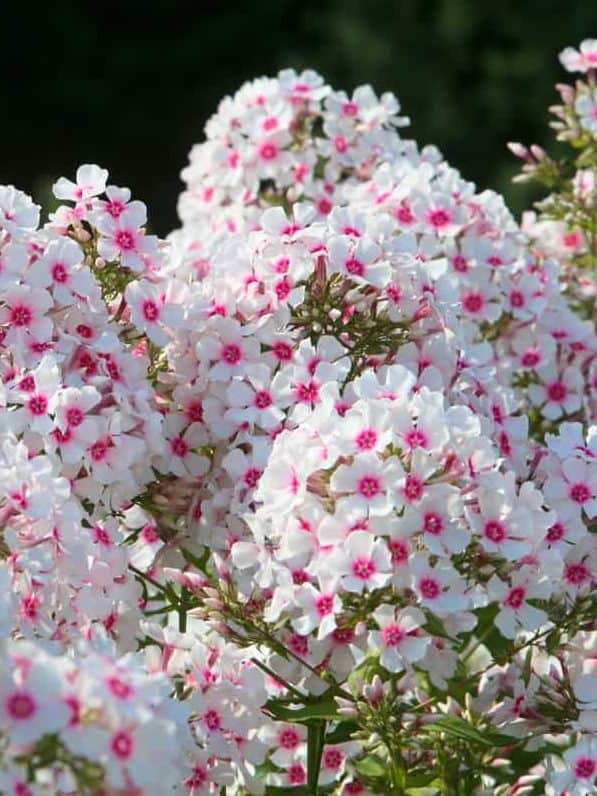
This perennial is a wildflower favorite and features large clusters of blooms that grow from rigid stems.
Because of their diversity, you can find compact, medium, or long lengths. They come in various colors: white, red, pink, lavender, and salmon.
Planting this perennial in nutrient-rich, moist, well-draining soil is essential.
They require at least 6 hours of sunlight but can grow in partially shaded areas. Grow this plant in USDA plant hardiness zones 4 to 8.
It should receive 1 inch of watering each week during its growing season.
Add Phlox to your garden for a vibrant pop of color.
Click here to see more on Amazon
2. Perennial Geranium (Geranium sanguineum)
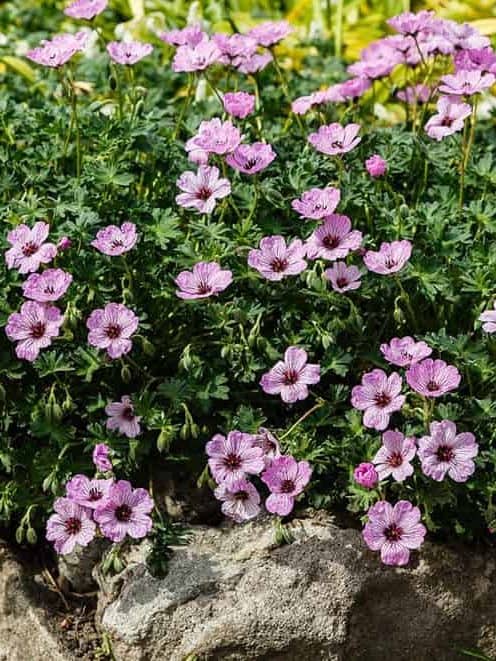
If you're looking for a high-bloom summer perennial, this is for you.
Depending on the variety, they can grow to a height between 6 and 18 inches and spread to a width between 18 and 24 inches.
The cup-shaped blooms may come in shades of white, red, pink, purple, and bi-color and may have single or double forms. The foliage is lush and green.
Its latin name is Geranium sanguineum. It's more commonly known as Cranesbill Geranium.
Grow these perennials in USDA plant hardiness zones 5 to 9. It grows best in partial shade and well-draining soil. They are susceptible to root rot if they're rooted in constantly wet soil.
Long-lasting blooms can be found on Perennial Geraniums, quickly adding vibrant color to the garden all summer long.
Click here to see more on Amazon
3. Lavender (Lavandula angustifolia)
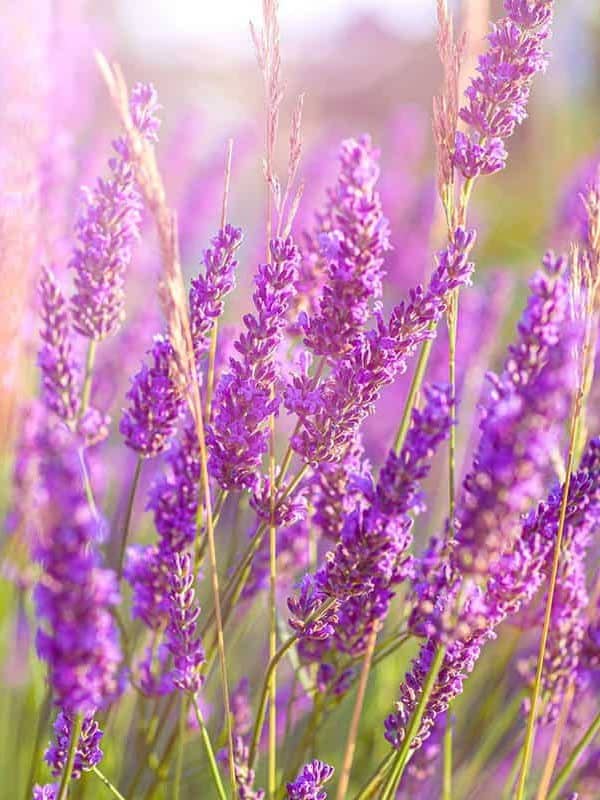
Aside from its alluring fragrance and culinary use, Lavender makes a beautiful addition to any garden. Its stunning flower spikes sit atop luscious green foliage and compact shrub-like form.
Despite what you may think, Lavender flowers can be lavender, white, pink, or even yellow. It can reach a height between 2 and 3 feet.
Its latin name is Lavandula angustifolia.
Grow it in USDA plant hardiness zones 5 to 8. It's a tough perennial that performs best in full sun and well-draining, dry soil. Please don't plant it in soil that's very acidic (it needs slightly alkaline soil), and don't overwater it.
You can enjoy this perennial's appearance and fragrance all through the summer.
Click here to see more on Amazon
4. Stella de Oro (Hemerocallis)
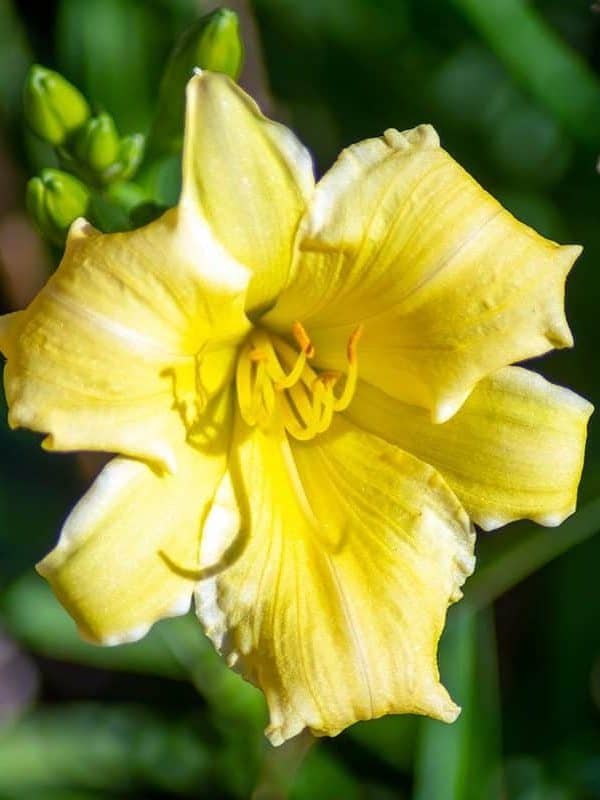
This compact daylily is a favorite amongst gardens due to its low maintenance requirements and beautiful blooms.
It blooms between May and July and re-blooms over a long period of time.
It reaches a height of 12 inches and has bright yellow, trumpet-shaped fragrant blooms.
Its Latin name is Hemerocallis, stemming from two Greek words, "hemera" and "kallos", meaning "day" and "beauty," respectively.
USDA plant hardiness zones 3 to 9 are where it grows. Full sun is ideal, but it can grow in partial shade, too.
It needs well-draining soil, and having nutrient-rich soil will ensure its health. Water it deeply in its first growing season so it can establish a deep root system.
The golden trumpet-shaped blooms will be sure to brighten up your garden!
Click here to see more on Amazon
5. Ice Plant (Delosperma)

Dainty, daisy-like blooms grow from succulent foliage. This plant forms a low mat of foliage that creates interest and texture.
The vibrant 2-inch blooms come in purple, white, pink, and yellow colors.
Its name comes from the little glossy dots that decorate the foliage, resembling ice crystals. It reaches a height between 6 and 8 inches.
Its Latin name is Delosperma.
Grow it in USDA plant hardiness zones 5 to 9. Plant it in direct sunlight, where it can receive at least 6 hours of sun.
It can survive in partially shaded areas but won't have nearly as many blooms. Well-draining soil is a necessity. Water it deeply in its first growing season.
Aside from the long-lasting blooms, the Ice Plant has alluring succulent foliage.
6. Dianthus (Dianthus sp.)
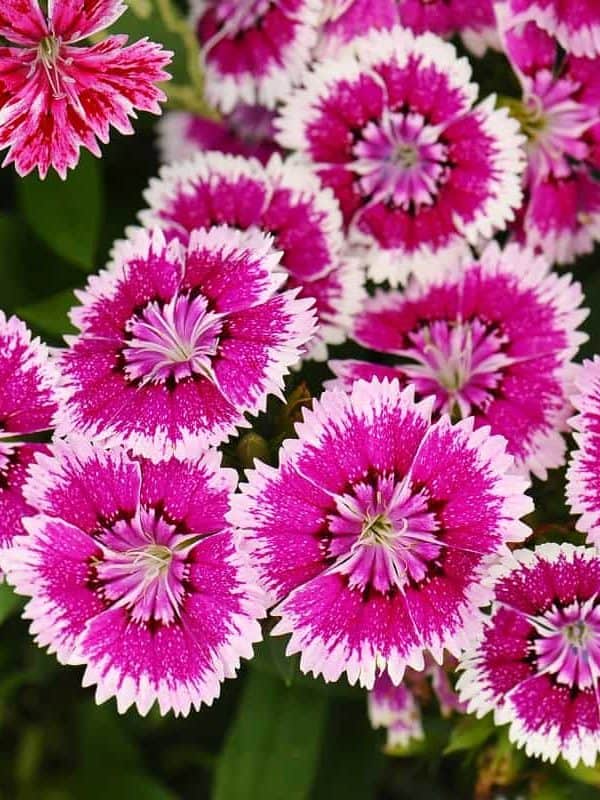
Dianthus can be an annual, biennial, or perennial, but we'll focus on the latter. They look like mini carnation flowers with jagged edges on the petals that are either single or double in form.
Their colors come in white, pink, red, and lavender shades. They can bloom from spring or summer and into the fall.
Three varieties act as perennials; their Latin names are Dianthus plumarius, D. superbus, and D. deltoides.
Their USDA plant hardiness zones are 3 to 9. They need full sun and nutrient-rich, well-draining soil.
The soil should also be neutral to slightly alkaline. Water them weekly so that they receive about 1 inch each week.
Click here to see more on Amazon
7. Dwarf Sea Holly (Eryngium)
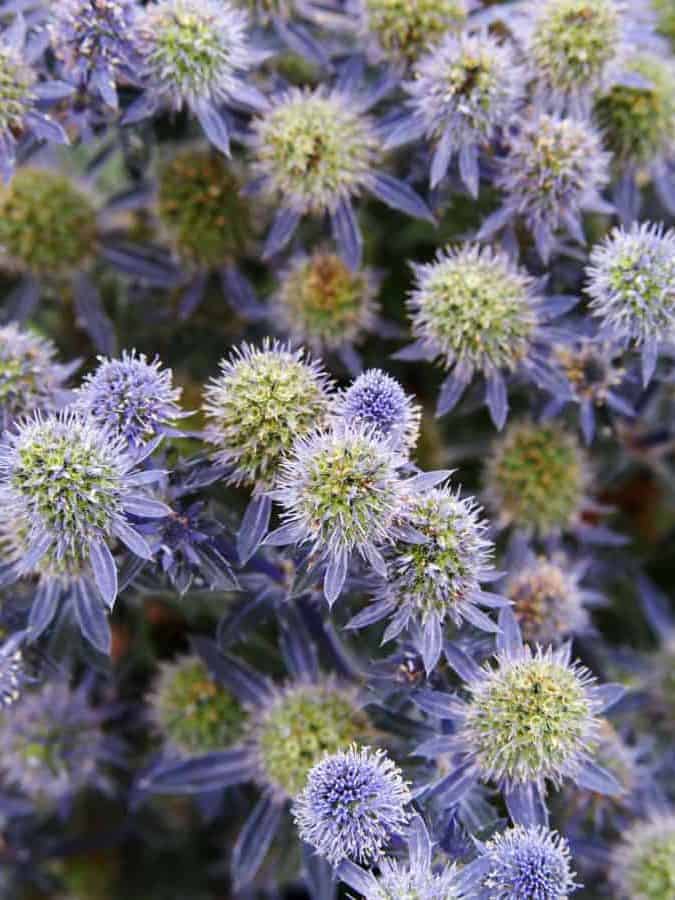
This heavily flowering perennial features beautiful purplish-blue blooms and silver-green foliage. Its colors are rounded like a Pincushion Flower and sit above profoundly toothed leaves.
It can reach about a foot in height and will spread between 8 and 10 inches in width. Blooms last from early summer and can span into the fall.
Its Latin name is Eryngium.
It performs best in USDA plant hardiness zones 4 to 9. It will require full sun or partial shade (at least 6 hours of sunlight) with weekly watering until it has been established.
Well-draining soil is a must, but it can tolerate any soil quality.
Deadheading will promote the growth of more blooms during both current and future growing seasons.
Click Here To See This Sea Holly On Amazon
8. Periwinkle (Catharanthus roseus)
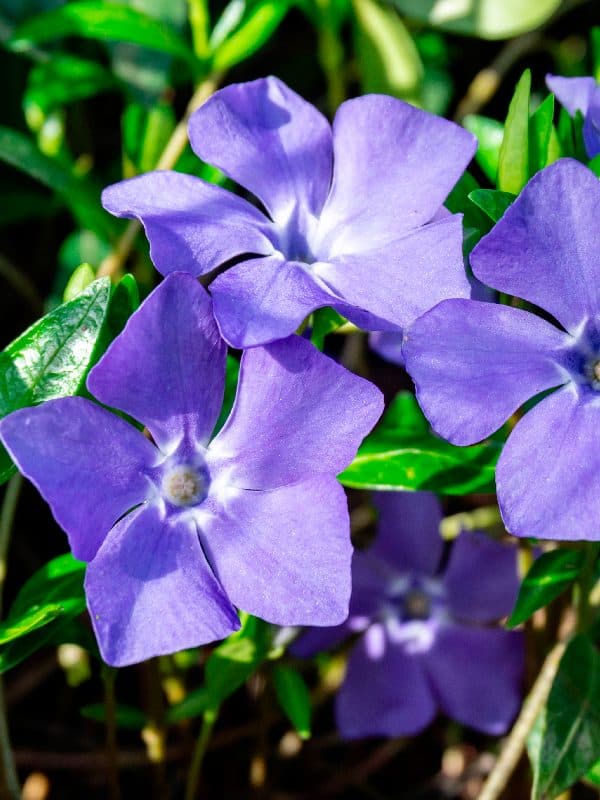
Continuous blooms are visible from the spring and into the fall and come in shades of white, pink, purple, and red. Their foliage is dark green, and each leaf measures between 2 and 3 inches in length.
The plant forms a dense mound that can reach a height between 2 and 3 feet.
Its latin name is Catharanthus roseus.
Surprisingly, Periwinkle doesn't prefer soil rich in nutrients, but it does like well-draining soil.
Full sun or partial shade is a necessity. It's drought and heat-resistant. USDA plant hardiness zones 4 to 9.
Adding Periwinkle to your garden will ensure a sense of beauty and elegance.
Click here to see more on Amazon
9. Perennial Violet (Viola)
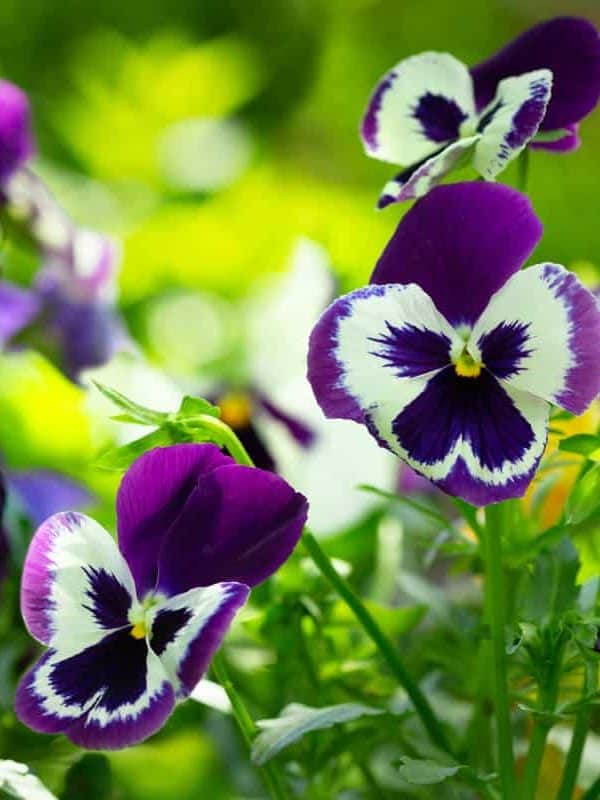
These perennials can reach a height between 6 and 12 inches and, depending on the variety, can spread over 6 inches in width.
Its scalloped foliage is a beautiful shade of green.
Violets are known for their bright jewel colors that can be seen in shades of white, pink, red, purple, blue, orange, and yellow.
Some look so unique and intricate that you'd think they were hand-painted.
Its Latin name is Viola.
Though challenging, cold-hardy plants need moist soil rich in nutrients. Full sun to partial shade is its optimal growing condition.
With over 500 species, it's no surprise that Violets have an extensive range of where they can grow: USDA plant hardiness zones 2 to 11 are well suited for various varieties.
Click here to see more on Amazon
10. Bellflower (Campanula)
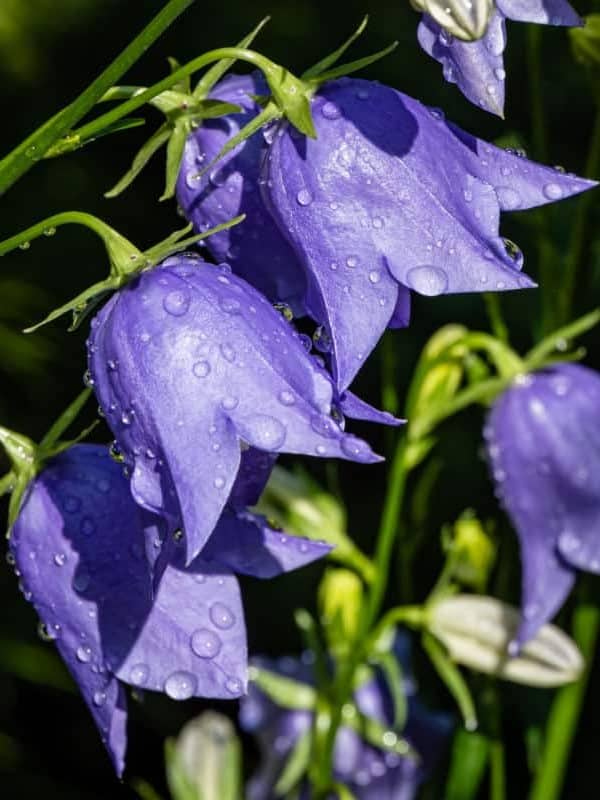
Vibrant bell-shaped blooms define this plant and can be seen in shades of purple, white, pink, and red. Their blooms last throughout the summer and can sometimes stay through the fall.
Depending on the variety, they can be low-growing or stand upright and range between a height of 1 to 6 feet.
Its Latin name is Campanula.
USDA plant hardiness zones 4 to 8 are best suited for its growth. It needs well-draining soil with a moderate amount of moisture.
It performs best in full sun. Ensure that these plants receive an inch of water each week.
Click here to see more on Amazon
11. Cup flower (Nierembergia)
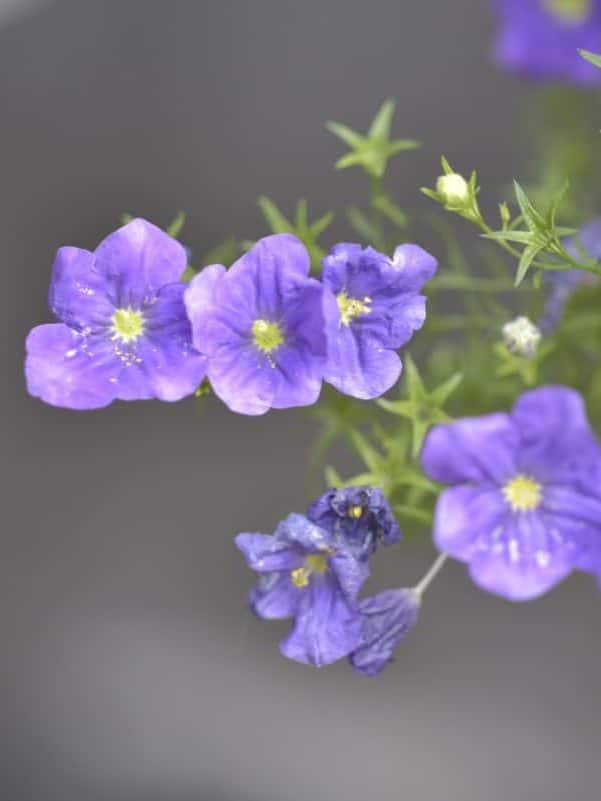
Commonly known as a cup flower, this perennial shows off its beautiful blooms from the summer and fall.
Their blooms come in creamy white or bluish-purple and have a yellow center.
Nierembergia has a mounding growth habit and spreads between 12 and 15 inches wide. It can grow to a height between 6 and 8 inches.
Its Latin name is Nierembergia.
It grows as a perennial in USDA plant hardiness zones 7 to 10, giving it a much smaller range.
It needs to be planted in well-draining soil rich in nutrients and will grow in full sunlight or partial shade.
Try to keep the soil moist but not waterlogged.
Click here to see more on Amazon
12. Common Vervain (Verbena officinalis)

These plants typically grow between 6 and 10 inches in height and have attractive clusters of flowers and dark, hairy foliage.
They may be shades of white, pink, red, and purple, many having a different colored center of the bloom. The blooms last from mid-summer until fall.
Its Latin name is Verbena officinalis.
This perennial needs at least 6 hours of sunlight each week and at least 1 inch of water.
It isn't particular about its oil components but needs to be well-draining. It performs best in USDA plant hardiness zones 2 to 8, making it a freezing hardy plant.
Enjoy Verbena blooms throughout the summer; they look great in your garden and containers.
Click here to see more on Amazon
13. Alyssum (Lobularia maritimum)
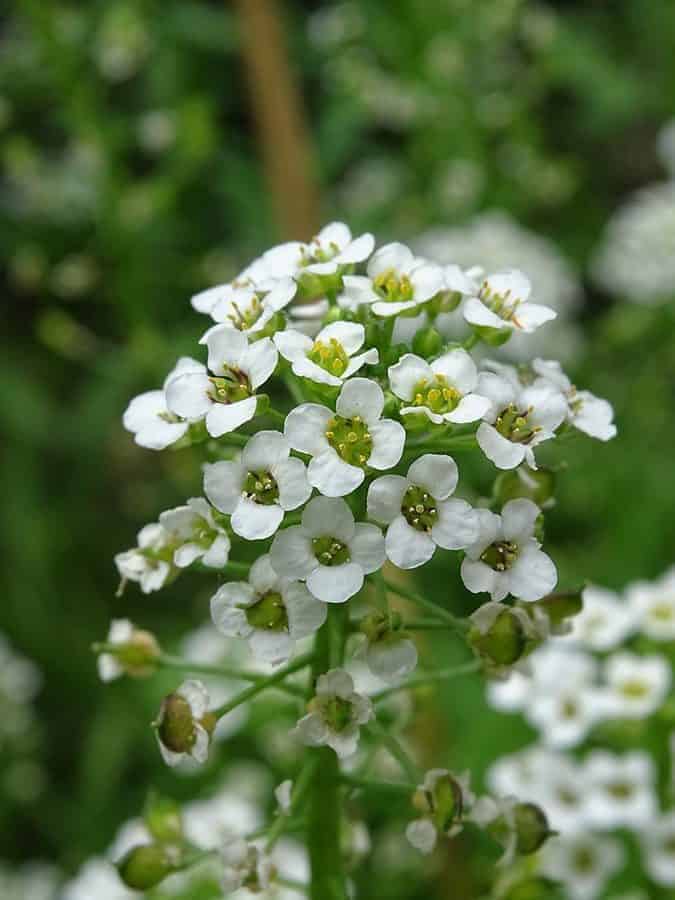
Small, dainty blooms decorate this perennial abundantly during the summer months. The plants remain short and grow like a mat, reaching between 4 and 6 inches in height and 6 to 9 inches in width.
White is the most common color of blooms, but you can also see Alyssum in shades of pink and purple.
Its Latin name is Lobularia maritimum.
Though technically a perennial, many gardeners treat it as a cold-hardy annual. It can grow in either full or partial sun and needs well-draining soil. USDA plant hardiness zones 7 to 11 are best suited for its growth.
Sweet Alyssum's abundant delicate blooms create more depth and texture in the garden.
Click here to see more on Amazon
14. Midget Pincushion Plant (Knautia macedonica)

As a dwarf variety, this herbaceous plant grows shorter than other Pincushion Plants, reaching a height of up to 1 and 1/2 feet.
Ruby red, round blooms appear from late spring until the fall. Its foliage is vibrantly green and pinnate.
Its Latin name is Knautia macedonica.
This perennial performs best in USDA plant hardiness zones 5 to 8. It performs best in full sun but needs protection from the wind.
Well-draining, nutrient-rich soil is a necessity for its health. Keep the soil moist but not waterlogged. Once it has been established, it can be drought-resistant.
Pincushion plants are unique and display an exciting texture and pop of color.
Click here to see more on Amazon
15. Eastern Pasqueflower (Pulsatilla Patens)
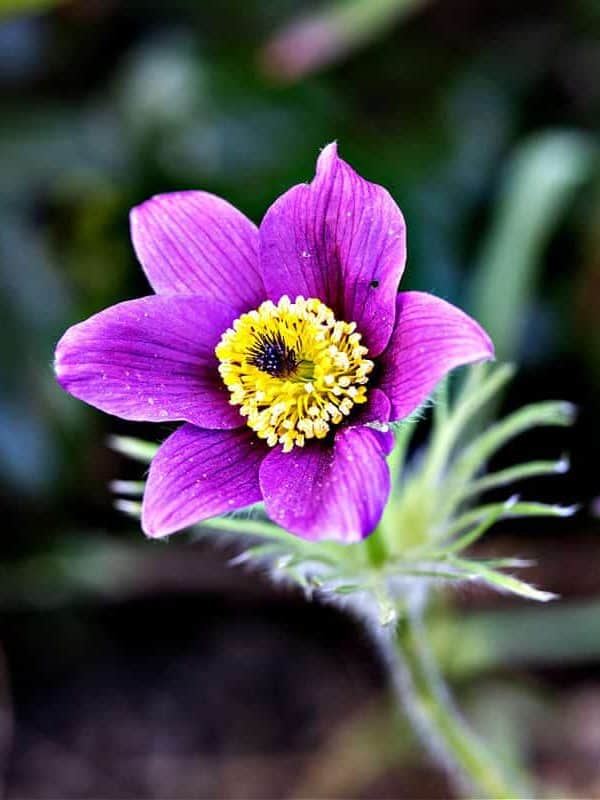
A proud native to the North American meadows, the Eastern Pasqueflower is a treat for the eyes.
With a unique look, its bright purple blossoms can remind you of fluffy pompoms.
Best of all? They start their show early in spring, signaling the start of the season.
Its Latin name is Pulsatilla Patens.
Known for their slow growth rate, these flowers have made their mark in North America and parts of Europe and Asia.
If you're thinking about the perfect zones to grow them, they thrive in USDA plant hardiness zones 3 to 8.
When it comes to sunlight, they are pretty flexible. They can bask in full sun or be content with partial shade.
As for the soil, they prefer it well-draining and lean towards the alkaline side.
Got drought or poor soil conditions? No worries! Eastern Pasqueflower has got your back.
Plus, deer tend to steer clear of them. In terms of care, they're pretty low-maintenance.
Fertilizers? They're good without them. Just ensure you deadhead them post-flowering to keep them looking their best.
 Click here to see more on Amazon
Click here to see more on Amazon
At-A-Glance Low-Growing Short Perennials For Borders
Gardening can be a fulfilling hobby but often requires a substantial time commitment.
Low-maintenance short perennials are the answer for those who wish to enjoy gardening without exhaustive upkeep.
These compact beauties offer vivid hues and intriguing textures. Plus, they come back to charm you year after year with little fuss.
Let's explore a selection of these garden gems:
| Plant Name | Height | Flowering Time | Care & Location | Special Features |
|---|---|---|---|---|
| Creeping Jenny (Lysimachia nummularia) | 2-4 inches | Late spring to early summer | Full sun to part shade; moderate watering | Golden-yellow foliage; ground cover/trailing over pots. |
| Cascading habit: pink, purple, blue flowers. | 3-6 inches | Spring | Full sun; well-drained soil | Carpet-like growth; pink, purple, white colors. |
| Lamb's Ear (Stachys byzantina) | 6-12 inches | Late spring to early summer | Full sun; drought-tolerant | Silvery, velvety leaves. |
| Sweet Woodruff (Galium odoratum) | 8-12 inches | Late spring | Partial to full shade; moist soil | White star-shaped flowers; shade lover. |
| Aubrieta (Aubrieta deltoidea) | 3-6 inches | Spring | Full sun; well-drained soil | Cascading habit; pink, purple, blue flowers. |
| Dwarf Daylilies | 12-18 inches | Summer | Full sun to partial shade; adaptable to various soil types | Wide range of colors; resilient against pests and diseases. |
6 Low-Growing Perennials for Border Decor
Gardening borders often need short and vivid plants to provide a neat frame and a pop of color.
Low-growing perennials are a go-to choice for such tasks.
Here are some prime picks to consider:
Creeping Jenny (Lysimachia nummularia): A vibrant ground cover that turns golden-yellow in full sun. It sprawls effortlessly, creating a dense mat.
Moss Phlox (Phlox subulata): A spring bloomer, its carpet-like spread showcases vibrant colors like pink, white, or purple.
Lamb's Ear (Stachys byzantina): Known for its velvety silver foliage, it adds texture to your garden borders.
Sweet Woodruff (Galium odoratum): A shade-loving perennial that blooms delicate white flowers in spring.
Aubrieta (Aubrieta deltoidea): Often cascading over walls, its purples, pinks, and blues add depth to border spaces.
Pussytoes (Antennaria dioica): They're a unique addition with soft gray-green foliage and tiny pink or white blooms.
Dwarf Daylilies: Perfect for borders due to their short stature and vivid colors.
Remember, the beauty of low-growing perennials lies not only in their visual appeal but also in their low maintenance and persistent bloom.
When designing your garden, utilize these perennials for a functional and eye-catching border.
Designing with Low-Growing Perennials
Borders and edges provide structure to a garden. To outline these areas with finesse, consider low-growing perennials.
Not only do they offer aesthetic charm, but their easy-going nature makes maintenance a breeze.
The Allure of Short Perennials
Easy To Grow: Generally, they require less water, fewer nutrients, and minimal pruning.
Space Efficiency: Their compact size is ideal for small gardens, containers, or tight spaces like borders and walkways.
Visual Appeal: Despite their small size, they offer striking colors and shapes that can serve as excellent focal points or accents.
Expert Tips For Nurturing Your Petite Perennials
Soil Prep: Though adaptable, these plants thrive when given a good start. Enrich the soil with organic matter to enhance water retention and breathability.
Hydration: Even low-maintenance plants need a drink. Water them well, especially during parched spells.
Mulch Magic: A protective mulch layer helps conserve moisture and deters weeds.
Nutrition: A sprinkle of slow-release fertilizer at the onset of spring usually suffices for these modest feeders.
Mind the Gap: To attain that picture-perfect garden look, adhere to the spacing guidelines for each plant. It ensures they flourish while maintaining the desired visual appeal.
After exploring low-growing perennials in detail, you might have specific queries about certain plants.
Many gardeners do.
To help clarify things, let's address some frequently asked questions about these beautiful garden additions.
Frequently Asked Questions (FAQs) About Perennials
1. What are the sunlight requirements for Phlox?
Phlox requires at least 6 hours of sunlight but can grow in partially shaded areas.
2. How often should I water my Perennial Geranium?
They thrive in well-draining soil and are susceptible to root rot if rooted in constantly wet soil. So, water accordingly to keep the soil moderately moist.
3. Do all Lavender plants have lavender-colored flowers?
No, Lavender flowers can also be white, pink, or yellow.
4. What's unique about the Stella de Oro daylily?
Stella de Oro is a compact daylily known for its low maintenance and bright yellow, trumpet-shaped fragrant blooms.
5. Why is it called an "Ice Plant"?
The Ice Plant gets its name from the little glossy dots that decorate the foliage resembling ice crystals.
6. Are Violets cold-hardy plants?
Yes, Violets are tough and cold-hardy. Depending on the variety, they can grow in USDA plant hardiness zones ranging from 2 to 11.
7. How tall does the Bellflower grow?
Bellflowers can range from 1 to 6 feet, depending on the variety.
8. What is the ideal soil for Nierembergia?
Nierembergia thrives in well-draining soil that's rich in nutrients.
9. How long do Verbena blooms last?
Verbena blooms from mid-summer until fall.
10. Is Alyssum a perennial or annual?
Technically, Alyssum is a perennial, but many gardeners treat it as a cold-hardy annual.
11. How should I care for my Midget Pincushion Plant?
This plant prefers full sun and requires protection from the wind. Ensure the soil is well-draining and moist but not waterlogged.
Maximize Your Garden's Potential
In wrapping up, remember that low-growing perennials are the unsung heroes that can effortlessly elevate your garden's aesthetics with minimal care.
Their vibrant hues and unique textures make any space a visual treat.
When choosing the right plants, consider your soil, sunlight, and spacing needs.
Embrace the world of perennials, and watch your garden come to life season after season.
Happy gardening!
Even More Helpful Plant Lists!
Do you want to save on water, too? Cross this list with our list of 15 Drought-Tolerant Perennials that Bloom All Summer . More lists to check out -
15 Foundation Plants for the Front of Your House
19 dwarf evergreen shrubs for full sun
20 Shrubs That Like Wet Soil and Full Sun
